Sources and Reactivity of Ambient VOCs on the Tibetan Plateau: Insights from a Multi-Site Campaign (2012–2014) for Assessing Decadal Change
Abstract
1. Introduction
2. Materials and Methods
2.1. Sampling Sites
2.2. Sampling Procedure and Analysis Methods
2.3. The Propylene-Equivalent Concentration and the MIR Method
3. Results and Discussion
3.1. General Characteristics of Measured VOCs
3.2. Seasonal Variation Patterns of VOCs
3.3. VOCs Reactivity and Ozone Formation Potential
3.4. Source Implications of VOCs
3.5. Comprehensive Analysis of Air Mass Trajectories and VOC Source Characterization
4. Conclusions
Supplementary Materials
Author Contributions
Funding
Institutional Review Board Statement
Informed Consent Statement
Data Availability Statement
Acknowledgments
Conflicts of Interest
References
- Seinfeld, J.H.; Pandis, S.N. Atmospheric Chemistry and Physics: From Air Pollution to Climate Change; John Wiley & Sons: Hoboken, NJ, USA, 2012. [Google Scholar]
- Khan, A.; Kanwal, H.; Bibi, S.; Mushtaq, S.; Khan, A.; Khan, Y.H.; Mallhi, T.H. Volatile Organic Compounds and Neurological Disorders: From Exposure to Preventive Interventions. In Environmental Contaminants and Neurological Disorders; Emerging Contaminants and Associated Treatment Technologies, Akash, M.S.H., Rehman, K., Eds.; Springer: Cham, Switzerland, 2021. [Google Scholar] [CrossRef]
- Han, J.; Liu, Z.; Hu, B.; Zhu, W.; Tang, G.; Liu, Q.; Ji, D.; Wang, Y. Observations and explicit modeling of summer and autumn ozone formation in urban Beijing: Identification of key precursor species and sources. Atmos. Environ. 2023, 309, 119932. [Google Scholar] [CrossRef]
- Xue, L.K.; Wang, T.; Guo, H.; Blake, D.R.; Tang, J.; Zhang, X.C.; Saunders, S.M.; Wang, W.X. Sources and photochemistry of volatile organic compounds in the remote atmosphere of western China: Results from the Mt. Waliguan Observatory. Atmos. Chem. Phys. 2013, 13, 8551–8567. [Google Scholar] [CrossRef]
- Xu, Y.; Yan, Y.; Duan, X.; Peng, L.; Wu, J.; Zhang, X.; Wei, X.; Liu, Z.; Zhang, D.; Wei, X. Diurnal variation and source analysis of NMHCs at a background site of Nam Co (4730 m a.s.l.) in the interior area of Tibetan Plateau. Atmos. Pollut. Res. 2022, 13, 101520. [Google Scholar] [CrossRef]
- Xue, X.; Zha, F.; Wang, Y.; Zhang, Y.; Wang, Y.; Shen, Y.; Kang, Y.; Yao, D.; Tang, G.; Bian, J.; et al. Vertical distributions of VOCs in the Tibetan Plateau background region. Atmos. Ocean. Sci. Lett. 2024, 17, 100516. [Google Scholar] [CrossRef]
- Ye, C.; Guo, S.; Lin, W.; Tian, F.; Wang, J.; Zhang, C.; Chi, S.; Chen, Y.; Zhang, Y.; Zeng, L.; et al. Measurement report: Source apportionment and environmental impacts of volatile organic compounds (VOCs) in Lhasa, a highland city in China. Atmos. Chem. Phys. 2023, 23, 10383–10397. [Google Scholar] [CrossRef]
- Okamoto, S.; Tanimoto, H. A review of atmospheric chemistry observations at mountain sites. Prog. Earth Planet. Sci. 2016, 3, 34. [Google Scholar] [CrossRef]
- Cong, Z.; Kang, S.; Kawamura, K.; Liu, B.; Wan, X.; Wang, Z.; Gao, S.; Fu, P. Carbonaceous aerosols on the south edge of the Tibetan Plateau: Concentrations, seasonality and sources. Atmos. Chem. Phys. 2015, 15, 1573–1584. [Google Scholar] [CrossRef]
- Xu, W.; Xu, X.; Lin, M.; Lin, W.; Tarasick, D.; Tang, J.; Ma, J.; Zheng, X. Long-term trends of surface ozone and its influencing factors at the Mt Waliguan GAW station, China—Part 2: The roles of anthropogenic emissions and climate variability. Atmos. Chem. Phys. 2018, 18, 773–798. [Google Scholar] [CrossRef]
- Liu, Z.; Gao, W.; Yu, Y.; Hu, B.; Xin, J.; Sun, Y.; Wang, L.; Wang, G.; Bi, X.; Zhang, G.; et al. Characteristics of PM2.5 mass concentrations and chemical species in urban and background areas of China: Emerging results from the CARE-China network. Atmos. Chem. Phys. 2018, 18, 8849–8871. [Google Scholar] [CrossRef]
- Zhang, J.; Sun, Y.; Wu, F.; Sun, J.; Wang, Y. The characteristics, seasonal variation and source apportionment of VOCs at Gongga Mountain, China. Atmos. Environ. 2014, 88, 297–305. [Google Scholar] [CrossRef]
- Qin, G.; Gao, S.; Fu, Q.; Fu, S.; Jia, H.; Zeng, Q.; Fan, L.; Ren, H.; Cheng, J. Investigation of VOC characteristics, source analysis, and chemical conversions in a typical petrochemical area through 1-year monitoring and emission inventory. Environ. Sci. Pollut. Res. 2022, 29, 51635–51650. [Google Scholar] [CrossRef] [PubMed]
- Atkinson, R.; Arey, J. Atmospheric degradation of volatile organic compounds. Chem. Rev. 2003, 103, 4605–4638. [Google Scholar] [CrossRef] [PubMed]
- Carter, W.P. Development of ozone reactivity scales for volatile organic compounds. Air Waste 1994, 44, 881–899. [Google Scholar] [CrossRef]
- Atkinson, R.; Baulch, D.L.; Cox, R.A.; Crowley, J.N.; Hampson, R.F.; Hynes, R.G.; Jenkin, M.E.; Rossi, M.J.; Troe, J.; IUPAC Subcommittee. Evaluated kinetic and photochemical data for atmospheric chemistry: Volume II-gas phase reactions of organic species. Atmos. Chem. Phys. 2006, 6, 3625–4055. [Google Scholar] [CrossRef]
- Tang, J.H.; Chan, L.Y.; Chan, C.Y.; Li, Y.S.; Chang, C.C.; Liu, S.C.; Wu, D.; Li, Y.D. Characteristics and diurnal variations of NMHCs at urban, suburban, and rural sites in the Pearl River Delta and a remote site in South China. Atmos. Environ. 2007, 41, 8620–8632. [Google Scholar] [CrossRef]
- Suthawaree, J.; Kato, S.; Okuzawa, K.; Kanaya, Y.; Pochanart, P.; Akimoto, H.; Wang, Z.; Kajii, Y. Measurements of volatile organic compounds in the middle of Central East China during Mount Tai Experiment 2006 (MTX2006): Observation of regional background and impact of biomass burning. Atmos. Chem. Phys. 2010, 10, 1269–1285. [Google Scholar] [CrossRef]
- Tang, J.-H.; Chan, L.-Y.; Chan, C.-Y.; Li, Y.-S.; Chang, C.-C.; Liu, S.-C.; Li, Y.-D. Nonmethane hydrocarbons in the transported and local air masses at a clean remote site on Hainan Island, south China. J. Geophys. Res. 2007, 112, 1–12. [Google Scholar] [CrossRef]
- Tang, J.H.; Chan, L.Y.; Chang, C.C.; Liu, S.; Li, Y.S. Characteristics and sources of non-methane hydrocarbons in background atmospheres of eastern, southwestern, and southern China. J. Geophys. Res. 2009, 114, 1–18. [Google Scholar] [CrossRef]
- Blake, N.J.; Blake, D.R.; Sive, B.C.; Chen, T.-Y.; Rowland, F.S.; Collins, J.E.; Sachse, G.W.; Anderson, B.E. Biomass burning emissions and vertical distribution of atmospheric methyl halides and other reduced carbon gases in the South Atlantic region. J. Geophys. Res. Atmos. 1996, 101, 24151–24164. [Google Scholar] [CrossRef]
- Iwasa, Y.; Hayashi, R.; Satake, A. Optimal seasonal schedule for the production of isoprene, a highly volatile biogenic VOC. Sci. Rep. 2024, 14, 12311. [Google Scholar] [CrossRef]
- Guo, H.; So, K.L.; Simpson, I.J.; Barletta, B.; Meinardi, S.; Blake, D.R. C1–C8 volatile organic compounds in the atmosphere of Hong Kong: Overview of atmospheric processing and source apportionment. Atmos. Environ. 2007, 41, 1456–1472. [Google Scholar] [CrossRef]
- Mula, V.; Bogdanov, J.; Petreska Stanoeva, J.; Zeneli, L.; Mehmeti, V.; Gelmini, F.; Daci, A.; Berisha, A.; Zdravkovski, Z.; Beretta, G. Semi-Quantitative Characterization of Volatile Organic Compounds in Indoor and Outdoor Air Using Passive Samplers: A Case Study of Milan, Italy. Atmosphere 2025, 16, 1088. [Google Scholar] [CrossRef]
- Pinthong, N.; Thepanondh, S.; Kondo, A. Source Identification of VOCs and their Environmental Health Risk in a Petrochemical Industrial Area. Aerosol Air Qual. Res. 2022, 22, 210064. [Google Scholar] [CrossRef]
- Zhang, Z.; Wang, X.; Zhang, Y.; Lu, S.; Huang, Z.; Huang, X.; Wang, Y. Ambient air benzene at background sites in China’s most developed coastal regions: Exposure levels, source implications and health risks. Sci. Total Environ. 2015, 511, 792–800. [Google Scholar] [CrossRef]
- Kaushik, N.; Mishra, A.K.; Das, R.M. Assessment of benzene and toluene emissions in National Capital Region (NCR): Implications for health risks and ozone formation. Air Qual. Atmos. Health 2024, 17, 3015–3029. [Google Scholar] [CrossRef]
- Ho, K.F.; Lee, S.C.; Ho, W.K.; Blake, D.R.; Cheng, Y.; Li, Y.S.; Ho, S.S.H.; Fung, K.; Louie, P.K.K.; Park, D. Vehicular emission of volatile organic compounds (VOCs) from a tunnel study in Hong Kong. Atmos. Chem. Phys. 2009, 9, 7491–7504. [Google Scholar] [CrossRef]
- Leuchner, M.; Rappenglück, B. VOC source–receptor relationships in Houston during TexAQS-II. Atmos. Environ. 2010, 44, 4056–4067. [Google Scholar] [CrossRef]
- McMeeking, G.R.; Kreidenweis, S.M.; Baker, S.; Carrico, C.M.; Chow, J.C.; Collett, J.L.; Hao, W.M.; Holden, A.S.; Kirchstetter, T.W.; Malm, W.C. Emissions of trace gases and aerosols during the open combustion of biomass in the laboratory. J. Geophys. Res.-Atmos. 2009, 114, 5577–5594. [Google Scholar] [CrossRef]
- Xu, J.; Ma, J.Z.; Zhang, X.L.; Xu, X.B.; Xu, X.F.; Lin, W.L.; Wang, Y.; Meng, W.; Ma, Z.Q. Measurements of ozone and its precursors in Beijing during summertime: Impact of urban plumes on ozone pollution in downwind rural areas. Atmos. Chem. Phys. 2011, 11, 12241–12252. [Google Scholar] [CrossRef]
- Wang, H.L.; Chen, C.H.; Wang, Q.; Huang, C.; Su, L.Y.; Huang, H.Y.; Lou, S.R.; Zhou, M.; Li, L.; Qiao, L.P.; et al. Chemical loss of volatile organic compounds and its impact on the source analysis through a two-year continuous measurement. Atmos. Environ. 2013, 80, 488–498. [Google Scholar] [CrossRef]
- Song, Y.; Shao, M.; Liu, Y.; Lu, S.; Kuster, W.; Goldan, P.; Xie, S. Source apportionment of ambient volatile organic compounds in Beijing. Environ. Sci. Technol. 2007, 41, 4348–4353. [Google Scholar] [CrossRef] [PubMed]
- Liu, Y.; Shao, M.; Fu, L.; Lu, S.; Zeng, L.; Tang, D. Source profiles of volatile organic compounds (VOCs) measured in China: Part I. Atmos. Environ. 2008, 42, 6247–6260. [Google Scholar] [CrossRef]
- Liu, J.; Mu, Y.; Zhang, Y.; Zhang, Z.; Wang, X.; Liu, Y.; Sun, Z. Atmospheric levels of BTEX compounds during the 2008 Olympic Games in the urban area of Beijing. Sci. Total Environ. 2009, 408, 109–116. [Google Scholar] [CrossRef] [PubMed]
- Wang, Y.; Fang, F.; Li, J.; Zhang, P.; Ji, Z.; Shi, J.; Huang, J. High effective supersaturation offsets low aerosol hygroscopicity to promote orographic cloud formation over the southern Tibetan Plateau. npj Clim. Atmos. Sci. 2025, 8, 231. [Google Scholar] [CrossRef]
- Zhao, R.; Dou, X.; Zhang, N.; Zhao, X.; Yang, W.; Han, B.; Yu, H.; Azzi, M.; Wang, Y.; Bai, Z. The characteristics of inorganic gases and volatile organic compounds at a remote site in the Tibetan Plateau. Atmos. Res. 2020, 234, 104740. [Google Scholar] [CrossRef]
- Zhang, Y.; Xu, W.; Zhou, W.; Li, Y.; Zhang, Z.; Du, A.; Qiao, H.; Kuang, Y.; Liu, L.; Zhang, Z.; et al. Characterization of organic vapors by a Vocus proton-transfer-reaction mass spectrometry at a mountain site in southeastern China. Sci. Total Environ. 2024, 919, 170633. [Google Scholar] [CrossRef]
- Andreae, M.O.; Merlet, P. Emission of trace gases and aerosols from biomass burning. Glob. Biogeochem. Cycles 2001, 15, 955–966. [Google Scholar] [CrossRef]
- Liu, B.; Kang, S.; Sun, J.; Zhang, Y.; Xu, R.; Wang, Y.; Liu, Y.; Cong, Z. Wet precipitation chemistry at a high-altitude site (3326 m a.s.l.) in the southeastern Tibetan Plateau. Environ. Sci. Pollut. Res. Int. 2013, 20, 5013–5027. [Google Scholar] [CrossRef]
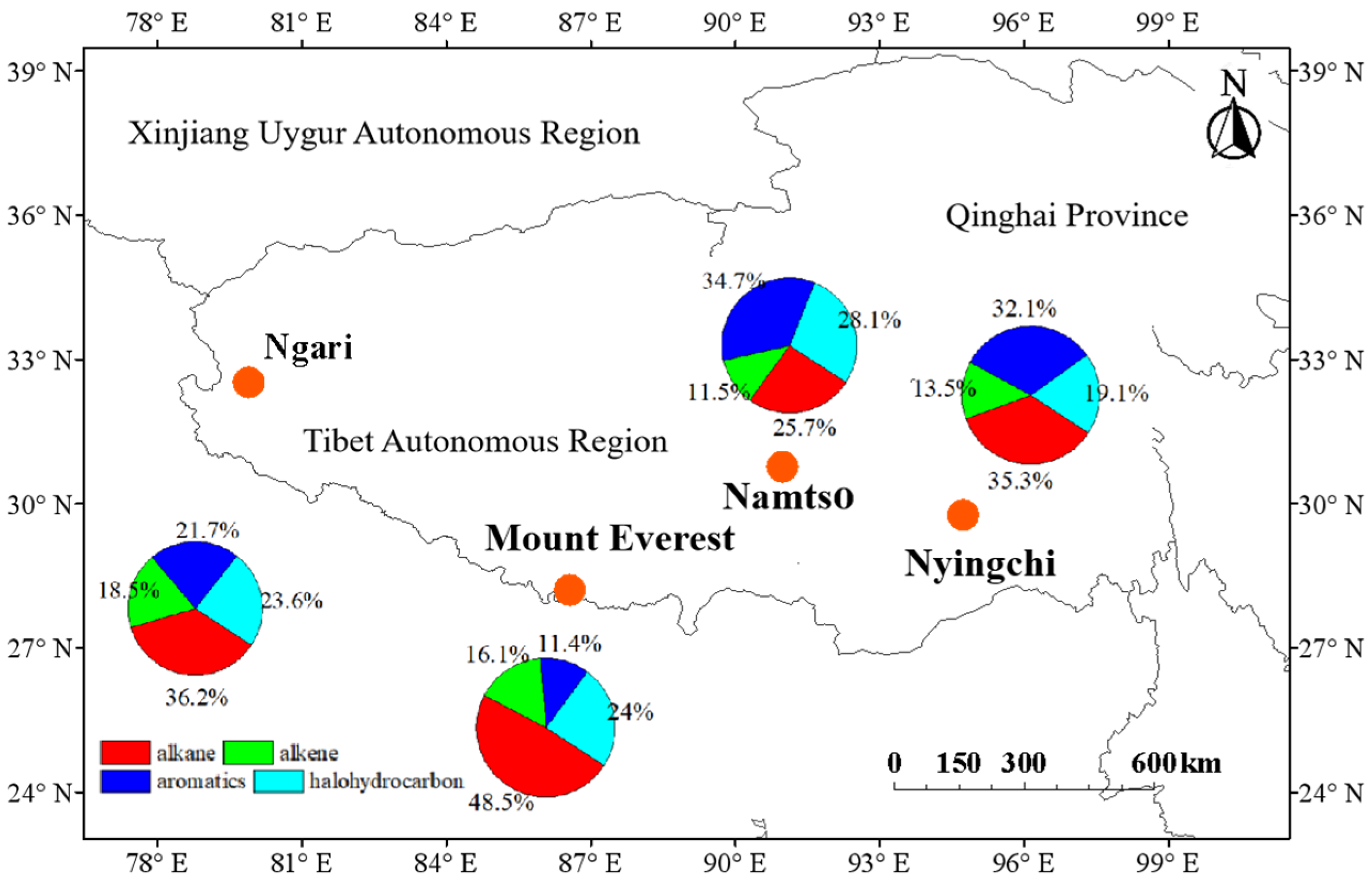
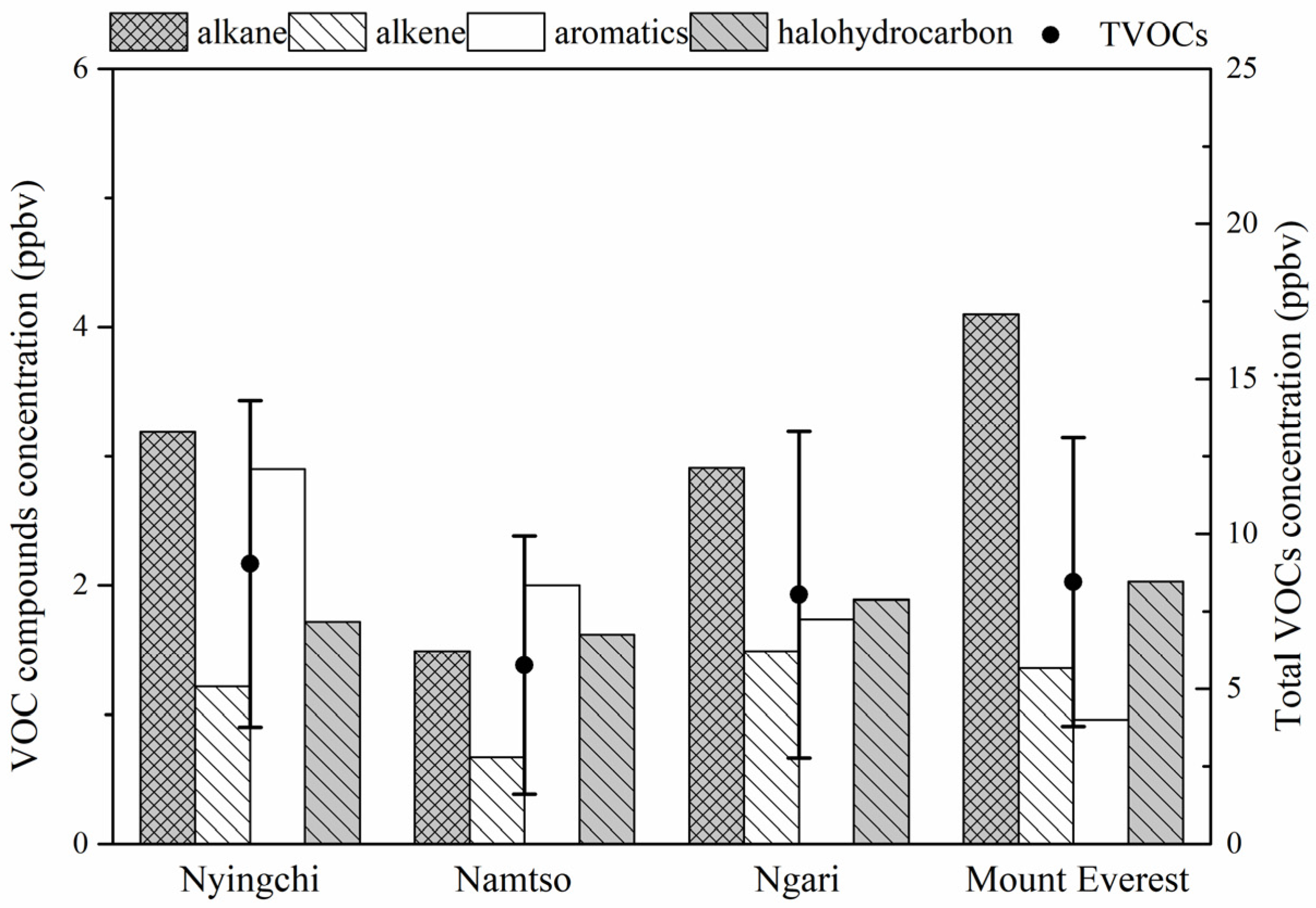
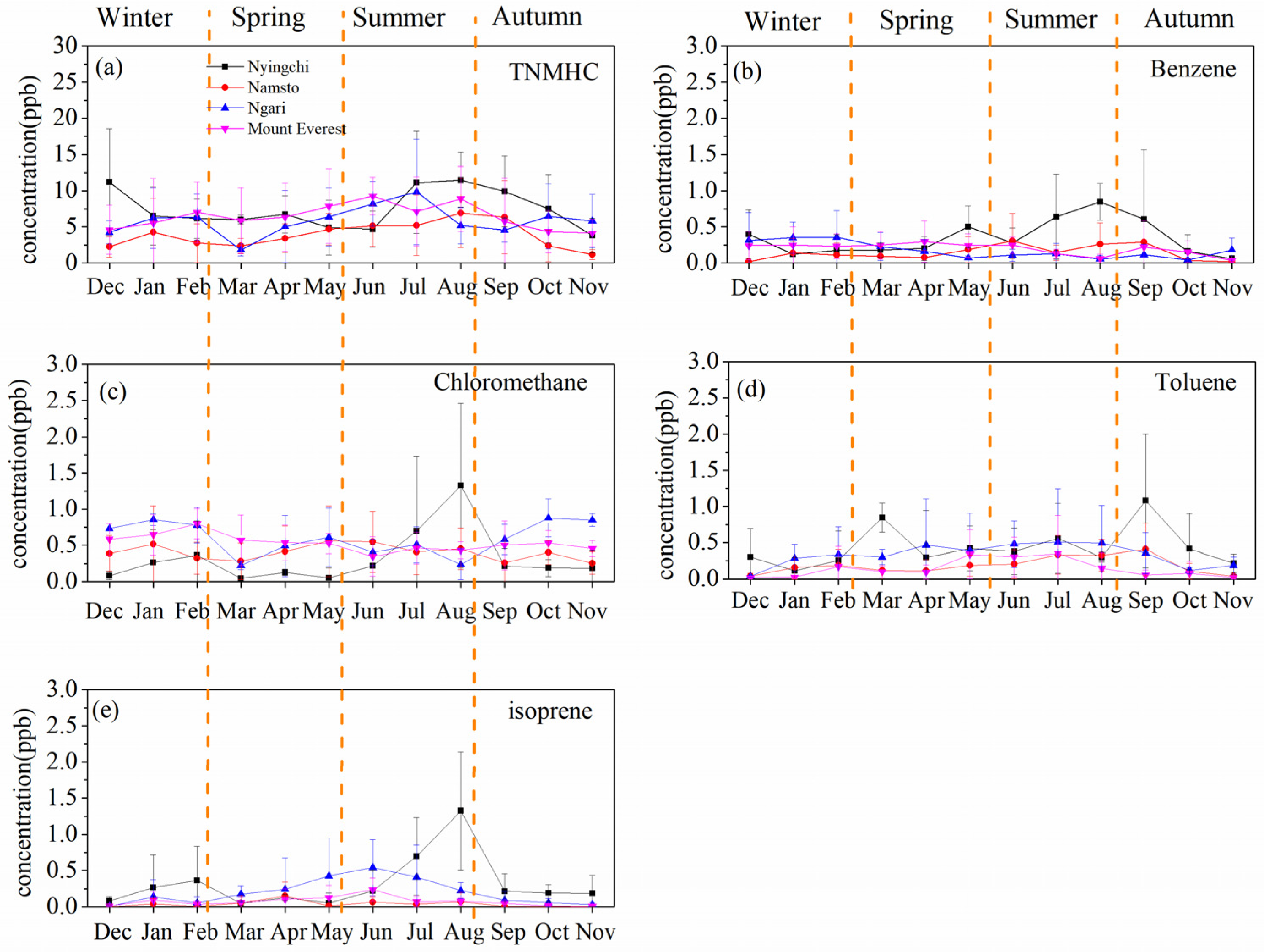
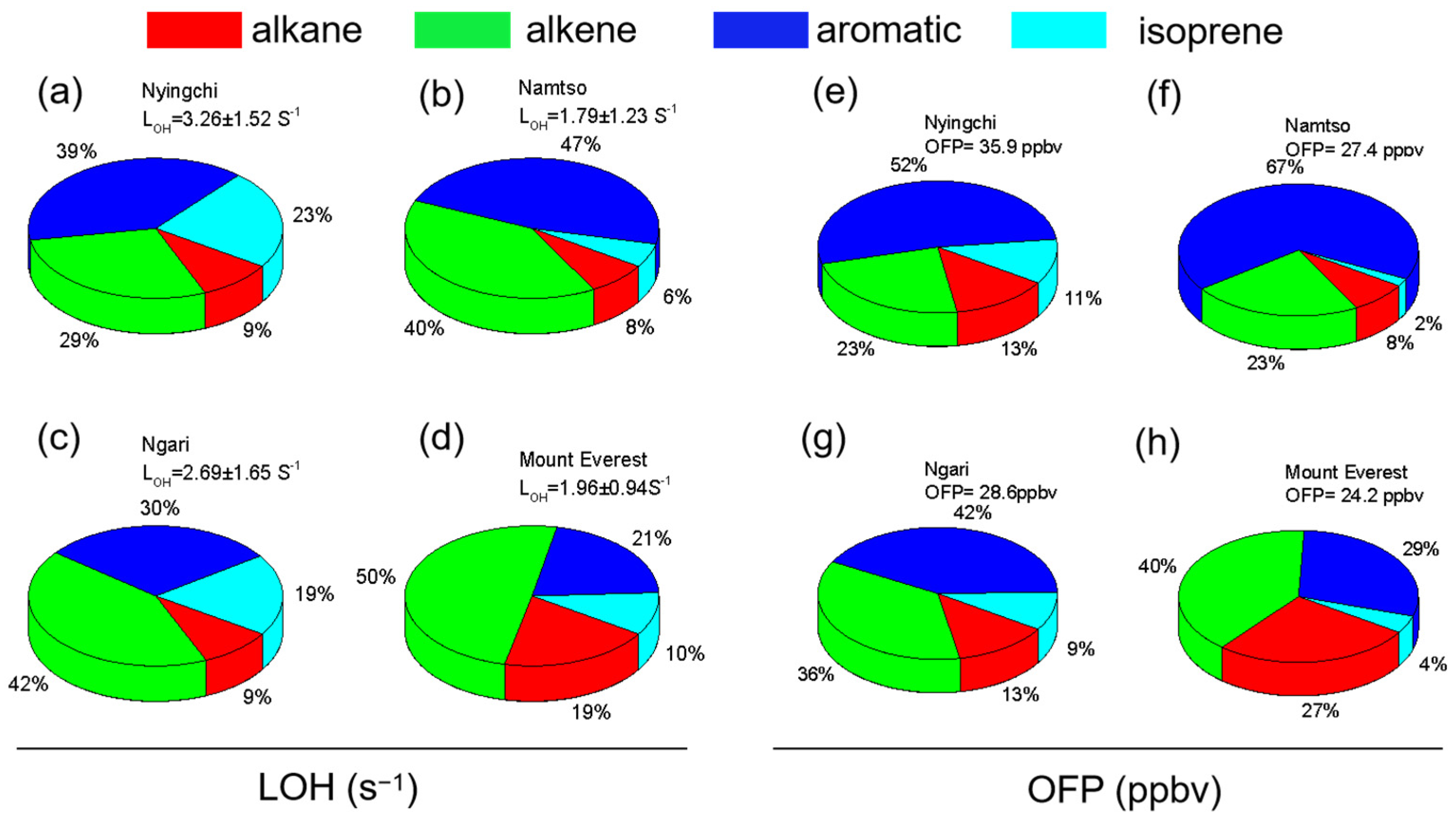
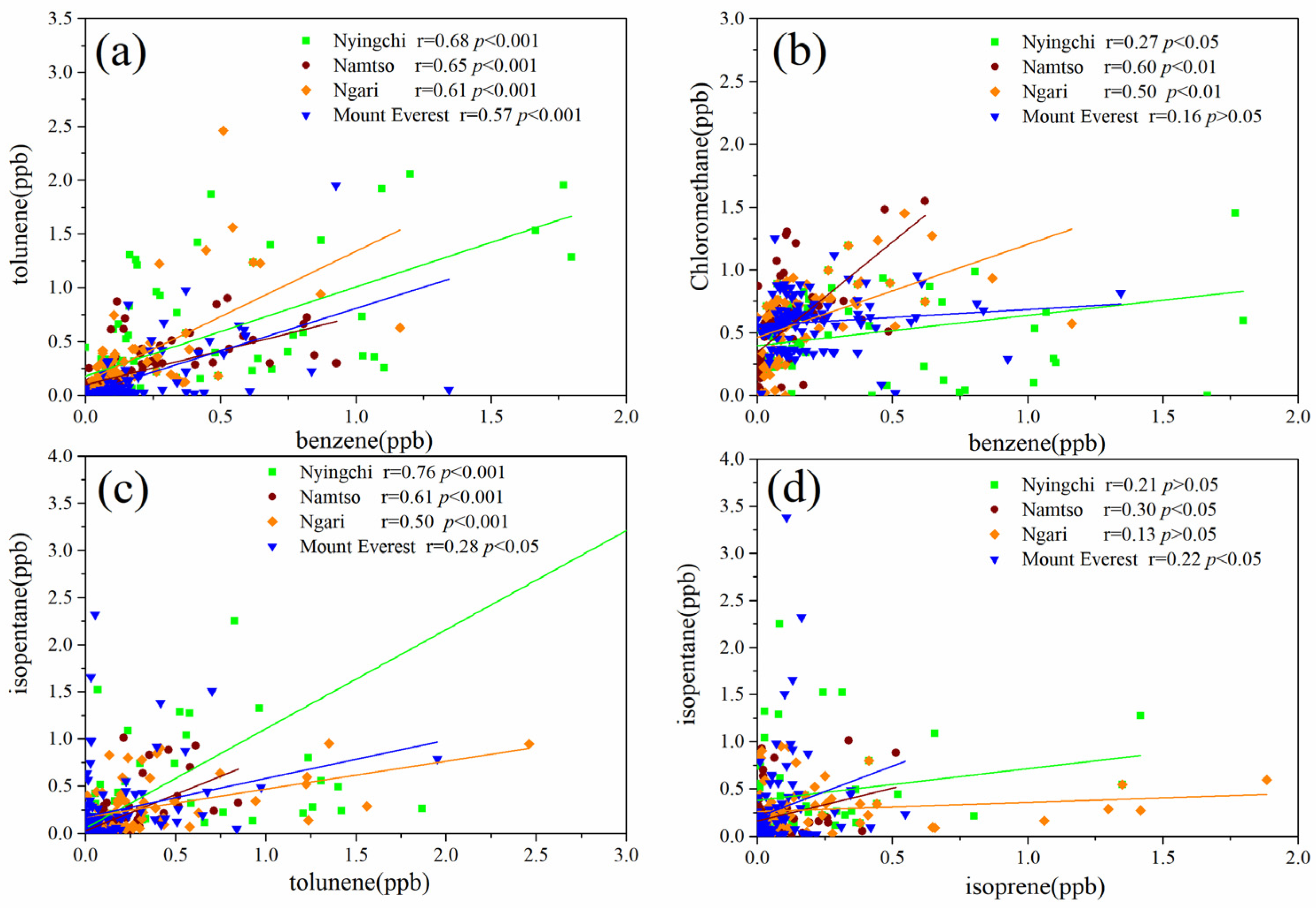
| Nyingchi | Namtso | Ngari | Mount Everest | Mt.Gongga a | Mt. Tai b | MT. JM c | Waliguan d | Lin’an e | TM f | ||
|---|---|---|---|---|---|---|---|---|---|---|---|
| Hydrocarbon | April 2012–October 2014 (n = 80) | January 2012–October 2014 (n = 102) | April 2012–February 2014 (n = 71) | January 2012–November 2014 (n = 131) | 2008–2011 | June 2006; | 7–13 and 16–18 April 2005 | 2003 (spring) | 2003 (summer) | April–May 2004 | April–May 2004 |
| propane | 0.21 | 0.19 | 0.43 | 0.36 | 0.62 (0.33) | 0.32 (0.19) | 0.28 (0.11) | 0.15 (0.04) | 1.24 (0.56) | 0.23 (0.07) | |
| Isobutane | 0.44 | 0.25 | 0.17 | 0.29 | 0.27 (0.26) | 0.16 (0.08) | 0.07 (0.05) | 0.06 (0.05) | 0.03 (0.02) | 0.42 (0.26) | 0.03 (0.010) |
| Butane | 0.27 | 0.24 | 0.32 | 0.20 | 0.20 (0.16) | 0.21 (0.14) | 0.10 (0.09) | 0.07 (0.04) | 0.04 (0.02) | 0.47 (0.26) | 0.06 (0.03) |
| isopentane | 0.27 | 0.12 | 0.27 | 0.23 | 0.47 (0.50) | 0.17 (0.09) | 0.08 (0.04) | 0.06 (0.06) | 0.07 (0.08) | 0.31 (0.28) | 0.15 (0.12) |
| Pentane | 0.14 | 0.11 | 0.13 | 0.07 | 0.22 (0.23) | 0.09 (0.05) | 0.04 (0.04) | 0.02 (0.01) | 0.02 (0.01) | 0.15 (0.11) | 0.12 (0.04) |
| propene | 0.12 | 0.05 | 0.32 | 0.23 | 0.11 (0.05) | 0.13 (0.07) | 0.03 (0.02) | 0.03 (0.02) | 0.34 (0.30) | 0.17 (0.07) | |
| isoprene | 0.30 | 0.04 | 0.20 | 0.08 | 0.40 (0.59) | 0.17 (0.18) | 0.48 (0.47) | 0.006 (0.02) | 0.13 (0.29) | 0.23 (0.52) | 0.16 (0.05) |
| Benzene | 0.34 | 0.16 | 0.18 | 0.20 | 0.72 (0.64) | 0.64 (0.35) | 0.21 (0.11) | 0.09 (0.05) | 0.07 (0.04) | 1.01 (0.63) | 0.24 (0.07) |
| Toluene | 0.46 | 0.20 | 0.34 | 0.15 | 0.44 (0.33) | 0.21 (0.12) | 0.09 (0.06) | 0.18 (0.27) | 0.06 (0.06) | 1.81 (1.60) | 0.16 (0.10) |
| Ethylbenzene | 0.19 | 0.20 | 0.10 | 0.05 | 0.28 (0.42) | 0.06 (0.08) | 0.02 (0.01) | 0.02 (0.04) | 0.007 (0.006) | 0.21 (0.16) | 0.03 (0.04) |
| m/p-Xylene | 0.17 | 0.26 | 0.14 | 0.07 | 0.28 (0.42) | 0.04 (0.07) | 0.04 (0.02) | 0.12 | 0.01 (0.01) | 0.50 | 0.06 (0.10) |
| o-Xylene | 0.14 | 0.23 | 0.12 | 0.05 | 0.31 (0.43) | 0.08 (0.07) | 0.02 (0.01) | 0.05 (0.08) | 0.009 (0.007) | 0.15 (0.14) | 0.03 (0.05) |
| Site | Season | Toluene/Benzene | Chloromethane/Benzene | Isopentane/Toluene | Site | Season | Toluene/Benzene |
|---|---|---|---|---|---|---|---|
| r | p | r | p | r | p | ||
| Nyingchi | winter | 0.84 | p < 0.001 | 0.71 | p < 0.001 | −0.01 | p > 0.05 |
| spring | 0.38 | p < 0.05 | 0.54 | p < 0.01 | 0.56 | p < 0.01 | |
| summer | 0.51 | p < 0.01 | −0.47 | p > 0.05 | 0.90 | p < 0.001 | |
| autumn | 0.90 | p < 0.001 | 0.57 | p < 0.001 | 0.53 | p < 0.01 | |
| Namsto | winter | 0.88 | p < 0.001 | 0.40 | p < 0.05 | 0.45 | p < 0.05 |
| spring | 0.80 | p < 0.001 | 0.43 | p < 0.05 | 0.57 | p < 0.05 | |
| summer | 0.38 | p > 0.05 | 0.13 | p > 0.05 | 0.79 | p < 0.001 | |
| autumn | 0.83 | p < 0.001 | 0.89 | p < 0.001 | 0.69 | p < 0.001 | |
| Ngari | winter | 0.64 | p < 0.001 | 0.70 | p < 0.001 | −0.11 | p > 0.05 |
| spring | 0.58 | p < 0.01 | 0.52 | p < 0.001 | 0.74 | p < 0.001 | |
| summer | 0.91 | p < 0.001 | 0.32 | p > 0.05 | 0.83 | p < 0.001 | |
| autumn | 0.81 | p < 0.001 | 0.41 | p < 0.05 | 0.51 | p < 0.01 | |
| Mount Everest | winter | 0.78 | p < 0.001 | 0.52 | p < 0.01 | 0.31 | p > 0.05 |
| spring | 0.60 | p < 0.001 | 0.50 | p < 0.01 | 0.51 | p < 0.01 | |
| summer | 0.60 | p < 0.001 | −0.24 | p > 0.05 | 0.77 | p < 0.001 | |
| autumn | 0.30 | p > 0.05 | 0.12 | p > 0.05 | −0.01 | p > 0.05 |
| Site | Nyingchi | Namsto | Ngari | Mount Everest | ||||||||
|---|---|---|---|---|---|---|---|---|---|---|---|---|
| Species (ppb) | NW (10%) | West (24%) | South (66%) | NW (30%) | West (53%) | South (27%) | NW (13%) | West (59%) | South (28%) | NW (15%) | West (62%) | South (23%) |
| Benzene | 0.10 | 0.28 | 0.42 | 0.12 | 0.20 | 0.18 | 0.10 | 0.20 | 0.20 | 0.15 | 0.22 | 0.22 |
| Toluene | 0.31 | 0.45 | 0.59 | 0.14 | 0.25 | 0.27 | 0.19 | 0.38 | 0.36 | 0.10 | 0.21 | 0.08 |
| Ethylbenzene | 0.18 | 0.15 | 0.27 | 0.16 | 0.19 | 0.35 | 0.07 | 0.11 | 0.04 | 0.04 | 0.06 | 0.03 |
| m/p-Xylene | 0.13 | 0.15 | 0.32 | 0.17 | 0.28 | 0.51 | 0.11 | 0.15 | 0.10 | 0.05 | 0.07 | 0.08 |
| o-Xylene | 0.11 | 0.11 | 0.21 | 0.17 | 0.24 | 0.40 | 0.09 | 0.13 | 0.10 | 0.03 | 0.06 | 0.05 |
| isoprene | 0.19 | 0.32 | 0.31 | 0.04 | 0.04 | 0.04 | 0.08 | 0.20 | 0.16 | 0.04 | 0.09 | 0.06 |
| propane | 0.11 | 0.30 | 0.21 | 0.13 | 0.08 | 0.03 | 0.41 | 0.41 | 0.67 | 0.31 | 0.32 | 0.77 |
| isopentane | 0.24 | 0.28 | 0.40 | 0.11 | 0.12 | 0.19 | 0.19 | 0.28 | 0.32 | 0.21 | 0.21 | 0.27 |
| Chloromethane | 0.41 | 0.54 | 0.61 | 0.40 | 0.46 | 0.43 | 0.49 | 0.58 | 0.68 | 0.45 | 0.56 | 0.64 |
| alkane | 3.59 | 3.03 | 3.28 | 1.30 | 1.77 | 1.56 | 1.88 | 3.41 | 2.52 | 3.43 | 3.99 | 5.26 |
| alkene | 0.76 | 1.24 | 1.33 | 0.57 | 0.73 | 0.86 | 0.81 | 1.59 | 1.90 | 1.04 | 1.43 | 1.64 |
| aromatics | 2.34 | 2.65 | 3.17 | 1.38 | 2.47 | 3.03 | 1.16 | 1.89 | 1.34 | 0.80 | 1.04 | 0.85 |
| NMHC | 6.69 | 6.91 | 7.78 | 3.30 | 4.97 | 5.45 | 3.85 | 6.89 | 5.76 | 5.27 | 6.45 | 7.75 |
Disclaimer/Publisher’s Note: The statements, opinions and data contained in all publications are solely those of the individual author(s) and contributor(s) and not of MDPI and/or the editor(s). MDPI and/or the editor(s) disclaim responsibility for any injury to people or property resulting from any ideas, methods, instructions or products referred to in the content. |
© 2025 by the authors. Licensee MDPI, Basel, Switzerland. This article is an open access article distributed under the terms and conditions of the Creative Commons Attribution (CC BY) license (https://creativecommons.org/licenses/by/4.0/).
Share and Cite
Wu, F.; Sun, J.; Wang, Y.; Liu, Z. Sources and Reactivity of Ambient VOCs on the Tibetan Plateau: Insights from a Multi-Site Campaign (2012–2014) for Assessing Decadal Change. Atmosphere 2025, 16, 1148. https://doi.org/10.3390/atmos16101148
Wu F, Sun J, Wang Y, Liu Z. Sources and Reactivity of Ambient VOCs on the Tibetan Plateau: Insights from a Multi-Site Campaign (2012–2014) for Assessing Decadal Change. Atmosphere. 2025; 16(10):1148. https://doi.org/10.3390/atmos16101148
Chicago/Turabian StyleWu, Fangkun, Jie Sun, Yinghong Wang, and Zirui Liu. 2025. "Sources and Reactivity of Ambient VOCs on the Tibetan Plateau: Insights from a Multi-Site Campaign (2012–2014) for Assessing Decadal Change" Atmosphere 16, no. 10: 1148. https://doi.org/10.3390/atmos16101148
APA StyleWu, F., Sun, J., Wang, Y., & Liu, Z. (2025). Sources and Reactivity of Ambient VOCs on the Tibetan Plateau: Insights from a Multi-Site Campaign (2012–2014) for Assessing Decadal Change. Atmosphere, 16(10), 1148. https://doi.org/10.3390/atmos16101148







